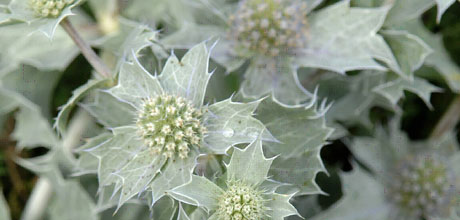Holly for a Hot Spot
This article was first published on 20 Apr 2012.

Holly
Not a real holly
Sea holly, the common name for this plant is misleading - the only resemblance to a holly is the spiky leaves. In fact, it is not even related to holly (Ilex spp.) and actually looks like a grey leaved thistle. The sea holly, Eryngium maritimum is an herbaceous plant that inhabits coastal sand dunes.
No sun screen needed
Eryngium maritimum can be found from Scotland to the Mediterranean and North Africa. It grows in amongst the sand dunes and has evolved several adaptations to enable survival in this harsh environment. The grey leaves help reflect the hot sun, waxy leaves reduce water loss and the long tap root anchors it into the sand and reach deep down for moisture. These adaptations make it a very drought tolerant plant, great for a sunny, dry, free draining spot. Because of the long tap root it dislikes disturbance and needs to be planted in its final location as a small plant.
A blue teasel
As well as the attractive grey-green foliage with prominent silver veins it bears blue teasel like flowers backed with large grey bracts in summer which persist well into the autumn. This makes a long lived display, great for cut flowers. It can be grown easily from seed reaching 60 cm tall when established.
Eryngium maritimum is growing on the lower side of the lowest path through the Mediterranean Garden at Dunedin Botanic Garden.
Dylan Norfield is the Geographic and Arboretum Collection Curator at Dunedin Botanic Garden


